Each summer resident or gardener professionally engaged in viticulture, wants to get an excellent grape harvest. Amateur Breeders They strive not only to cultivate the available varieties, but also to create some new and original one. Making many trials and mistakes in this matter, the originators manage to develop new hybrids that differ in unpredictable taste, high frost resistance and resistance to diseases. One of them is a hybrid "In memory of the surgeon."
Content
Grade description
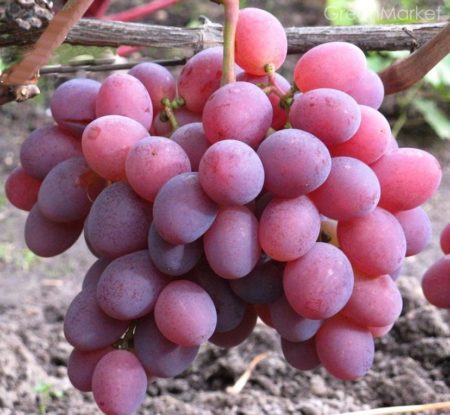 The hybrid form of table grapes "In memory of the surgeon" refers to the pink varieties, which are popular both among summer residents and in industrial production. From berries are made:
The hybrid form of table grapes "In memory of the surgeon" refers to the pink varieties, which are popular both among summer residents and in industrial production. From berries are made:
- wine;
- liqueurs;
- compotes;
- beverages;
- children's juices and mashed potatoes.
In addition, in-kind fruits are very attractive, as they have a bright but not intrusive flavor of strawberries. The hybrid was the result of the crossing of two parental forms: Kesha-Talisman and Kishmish Mirage. The author of the variety is a student of the “father” of modern viticulture, Ivan Kostrikin, a scientist at the All-Russian Research Institute named after Potapenko - Evgeny Pavlovsky. Being one of the best and promising hybrid forms from his collection, “In Memory of the Surgeon” has repeatedly received awards at the international competition of winegrowers in Crimea.
A few years ago, the variety passed its first tests, but there was no complete confirmation of its characteristics. In the following years after the creation of the hybrid, in different vineyards in many regions, the form proved to be a culture with great prospects, becoming popular among winegrowers throughout the former CIS.
The variety is distinguished by slightly oblong berries with a raspberry tint and medium-density skin. The fruit, at the stage of technical maturity, reaches a mass of 7g-10g with juicy sweet pulp, light sourness and a delicate nutmeg aroma. Sugar content of berries is 16% -19%, the amount of tartaric acid is 0.60% per 1000 ml of juice.
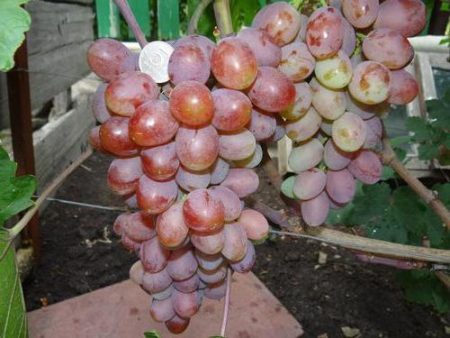
Hybrid during cultivation shows increased productivity, so in order to avoid peeling - the bushes must be unloaded. Taking resistance from low temperatures from -21 to -24 degrees from maternal forms, "Surgeon's Memory" calmly endures winter without shelter in the southern regions. However, in the central and northern regions, bushes should be covered. The choice of covering materials depends on the shape of the pruning vines in the fall.
The hybrid table form is one of the early varieties zoned for the southern and central regions. About four months pass from the moment the buds open to the technical maturation of the hands.
Characteristics
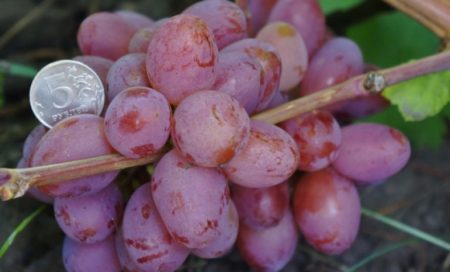 The collection of brushes “In memory of the surgeon” begins in the first ten days of August, ends in the last days of September. The hybrid is distinguished by varietal features:
The collection of brushes “In memory of the surgeon” begins in the first ten days of August, ends in the last days of September. The hybrid is distinguished by varietal features:
| Qualities | Characteristic |
| Ripening period | Early 115 to 125 days |
| Flower functionality | Bisexual |
| Bunch weight | 50g-700g (with improved agricultural technology up to 1200g) |
| Fetal mass | 7g-10g |
| Taste | Muscat with a light strawberry aftertaste |
| Bush | Medium |
| Frost resistance | -21 to -24 degrees without shelter |
| Disease resistance | Below average |
Benefits
"In memory of the surgeon" is in good demand among customers not only for its excellent presentation.Grapes also have many advantages:
- early ripening;
- high density of pulp and strong skin;
- good transportability;
- frost resistance;
- the percentage of cuttings forming the roots reaches 80% -85%.
disadvantages
Like any culture, the cultivation of "Surgeon's Memory" has its weaknesses in the form of:
- lower yields in case of grafting a vine to another variety;
- poor resistance to fungal diseases, bacterial cancer and callus;
- attack of wasps due to the aroma of the fruit;
- extinction due to improper vine formation or lack of nutrients.
Pollinating varieties
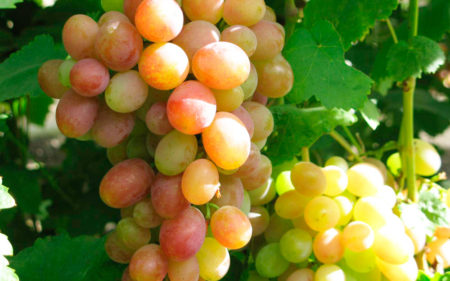 At a low air temperature at the beginning of flowering of the hybrid, its pollination proceeds very sluggishly. As a result, inferior sparse clusters ripen on the bushes, and the yield is reduced several times. With increased air humidity during flowering of grapes more than 80%, the stamens are waterlogged, and pollen has difficulty moving in the air stream. With reduced air humidity of less than 20%, autogamy of grapes is also difficult.
At a low air temperature at the beginning of flowering of the hybrid, its pollination proceeds very sluggishly. As a result, inferior sparse clusters ripen on the bushes, and the yield is reduced several times. With increased air humidity during flowering of grapes more than 80%, the stamens are waterlogged, and pollen has difficulty moving in the air stream. With reduced air humidity of less than 20%, autogamy of grapes is also difficult.
Therefore, experienced growers for safety plant next to the hybrid "In memory of the surgeon" varieties of pollinators.
Good results are obtained by planting swarm varieties of pollen carriers:
- Veles;
- Kishmish Sprinter;
- Premier
- Lowland 2;
- Northern AZOS;
- Venus
- Rusball;
- Zaporizhzhya;
- Relays;
- Ainset;
- Moldavian.
Cultivation
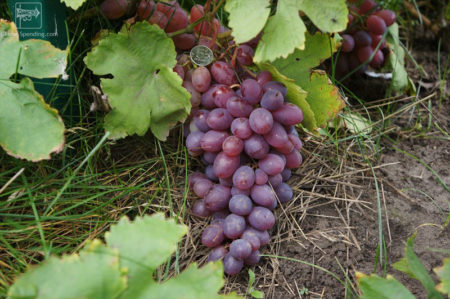
For vegetation, young plants will need nutritious, loose soil. The hybrid will feel best in chernozem with a high percentage of humus content. The Memory of the Surgeon will also take root well in stony or sandy soil with the addition of humus from plant and animal remains in the planting pits. Clay and peat soil will be liked by the variety least of all, therefore, before planting cuttings on the bottom of the planting hole, the remains of light porous building material or gravel should be laid.
Landing
Before planting in open ground, the young vine should be hardened. Even if, when buying a variety, the seller assured that he had carried out the necessary measures for hardening the plants, he should be safe. After all, plants that have not passed hardening will take root poorly and become ill. In the future, from such seedlings you can not wait for the harvest or they will simply perish, without even having time to start growing. Hardening, grapes for 7-10 days, proceed with planting:
- having dug a hole with a depth of 50cm-70cm, divide the selected soil into three parts, leaving the top layer 20m-30cm for laying on the bottom of the hole;
- having chosen the roots of weeds and larvae of insect pests, lay drainage at the bottom of the pit with a layer of 15cm-25cm, then pour out the fertile soil left;
- then lay 2 buckets of well-rotted cow manure mixed with 1 kg of wood ash and 1 glass of nitroammophoska;
- place a seedling in the hole so that its heel is located below the ground by 20cm-25cm;
- filling the stem with soil 6cm-7cm below the kidney level, compact the soil to eliminate voids;
- watering the plant with 20 liters of warm water, add soil, no longer compacting it. For good aeration, the topsoil must remain loose;
- lay around the plant with a layer of 20cm-25cm organics: hay, straw or wood chips mixed with saltpeter;
- drive wooden stakes or metal rods next to the plant as a temporary support, and tie them over with the growth of the seedling.
Bush formation
In the absence of experience in competent formation, a beginner in growing grapes will cope with pruning and shaping, following certain recommendations:
- in the first season of vegetation, the future bush should be set in the right direction of growth so that by the end of September it will form a pair of strong shoots. To do this, immediately after planting, cut out all the extra stepsons, leaving the two most powerful;
- in order for the healthy and strong vine to ripen in the first year, which will be laid for wintering in October, the plant needs to be fed twice a summer. The first foliar spraying with nutrients is carried out in mid-July based on 10 l of water: 20 g of urea, 20 g of superphosphate, 1 g of potassium permanganate. The second - in early September, based on 10 liters of water: 10 g of urea, 20 superphosphate, 30 g of potassium;
- after a successful wintering of the vine, in the second year of life, establish a support trellis above the bushes, to which to tie a plant at the end of May. In the second season, form three fruit vines, between which there should be a distance of 60cm-70cm. Cut out all the extra stepsons. Neutralization of weak arrows will provide an opportunity to form powerful fruitful links next year;
- for the third season, the plant fully enters the fruiting period. The buds, hatching on the shoulder of the bushes, pluck, leaving only those that are located on fruit vines. In the third year of life, form a plant in four arms, on which berry clusters will form after flowering. With the formation of many inflorescences on the vine, leave only two or three of the most powerful. Remove the remaining brushes, since when overloading the bush, the berries will be twice as small, and on the bunches the process of peeling will begin.
Winter preparations
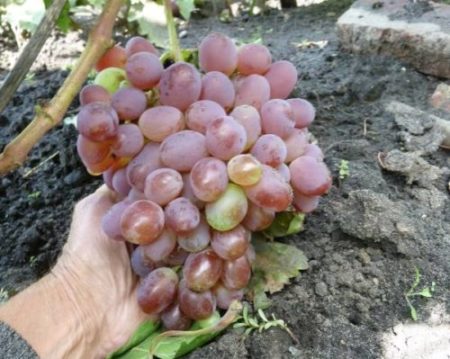 Despite the fact that the hybrid can withstand frosts without shelter up to -24 degrees, in regions where the air temperature drops below -19 degrees in winter, it should be covered.
Despite the fact that the hybrid can withstand frosts without shelter up to -24 degrees, in regions where the air temperature drops below -19 degrees in winter, it should be covered.
Inexperienced winegrowers, ending the season in summer cottages in mid-October, are in a hurry to shelter the culture. However, until the first steady frosts from -5 to -7 degrees, plants are physiologically not ready for wintering. Under cover material, they will actively breathe and vomit.
By the beginning of the winter period, the hybrid should be prepared during fruit ripening. For this:
- feed at the end of the season plants with phosphorus and potassium, which will increase the winter hardiness of the bushes, accelerate the ripening and lignification of the shoots;
- cut out all green shoots and "waste" fruit vines;
- carry out a moisture recharge that protects the root layer of the soil from the formation of voids into which frosty air will penetrate.
Reviews
Grape growers and amateurs who planted a hybrid “Surgeon's Memory” on their plots share their impressions.
Andrei Moscow Region
"The memory of the surgeon" has been growing in my vineyard for the fourth year. A very worthy variety, however, is struck by oidimum. It does not do without preventive treatments of bushes, since invasions of the pathogen kills the kidneys and rot the fruits. The berry is large, tasty, ripens early, however, is susceptible to attack by wasps.
Nina Krasnodar
In our climate, the hybrid form “Surgeon's Memory” shows excellent results. By mid-August, it is gaining sugar, ripens.I note good ripening of the vine, and with preventive spraying with fungicides - the absence of disease.
The hybrid form of table grapes has rightfully earned the respect of winegrowers in the southern and central regions for its quality of berries, resistance to frost and good survival of cuttings. And pink and purple brushes delight the eye both on the vegetable counters and in the dish on the kitchen table.




 Non-covering winter-hardy grape varieties for Moscow region
Non-covering winter-hardy grape varieties for Moscow region How to keep the vine in winter
How to keep the vine in winter When can I transfer grapes to another place in the fall
When can I transfer grapes to another place in the fall How to cover and prepare grapes for the winter in the suburbs
How to cover and prepare grapes for the winter in the suburbs